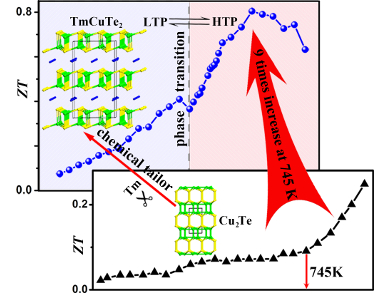The conversion of waste heat into electricity by the use of thermoelectric (TE) materials is a vision for the energy technologies for the future. At the State Key Laboratory of Structural Chemistry, Fuzhou, China, Lin Ming Wu and colleagues have achieved the synthesis of a new TE material, TmCuTe2, by means of a substructure approach. The introduction of Tm3+ ions breaks the strong metallic and covalent bonds in the parent Cu2Te, leading to the formation of ternary TmCuTe2 with a narrow band gap. The structure itself is made up of CuTe4-based layers that stack along the c axis and these layers are separated by Tm3+ ions.
The researchers have investigated the crystal structure relationship, thermal stability, phase transition, and band structure as well as the TE properties and their intrinsic origins. The effectiveness of the TE conversion is determined by the dimensionless figure of merit (ZT). The new material has a ZT value of 0.81 at 745 K, nine times higher than that found for the parent binary structure Cu2Te, thus making it a promising candidate for mid-temperature TE applications.
- Chemical Modification and Energetically Favorable Atomic Disorder of a Layered Thermoelectric Material TmCuTe2 Leading to High Performance,
Hua Lin, Hong Chen, Jin-Ni Shen, Ling Chen, Li-Ming Wu,
Chem. Eur. J. 2014.
DOI: 10.1002/chem.201404453



